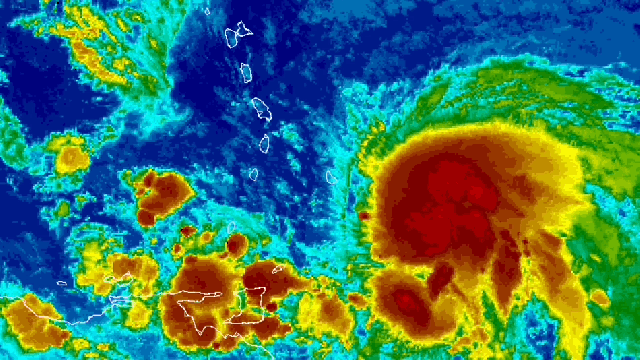The 2021 Atlantic hurricane season has gotten off to a record-setting pace with five named storms. And now, Elsa, one of that early spate of storms, has become the season’s first hurricane.
Elsa became a tropical storm on Thursday and ramped up to a hurricane by Friday morning just as it approached Barbados. The storm is packing winds of 75 mph (120 kph), making it a Category 1 hurricane. Hurricane-force winds whipped Barbados, though Hurricane Elsa technically didn’t make landfall since the eye took a turn just to the south of the island. The storm is expected to make a run toward the U.S. Though it’s still quite a ways away and the exact scenario is developing, it’s clear Elsa is a storm worth watching.
Elsa’s Current Situation
A storm doesn’t have to make landfall to have an impact. Videos from Barbados Friday morning show winds whipping through Bridgetown, the nation’s capital. Bands of rain also raked the island, particularly its south shore.
The National Hurricane Centre warned that 7.6 to 15.2 centimetres of rain could fall over a wide area, with some spots getting doused with up to 25.4 centimetres. Minor storm surge could also damage coastal locations, particularly as Elsa pushes toward the arc of islands known as the Lesser Antilles. St. Lucia and St. Vincent and the Grenadines are all under hurricane warnings. St. Vincent faced a volcanic eruption in April, and a hurricane is the last thing residents there need.
Could Elsa Make Landfall in the U.S.?
Longer term, Elsa is forecast to head to the U.S. by the middle of next week. The forecast that far out is subject to change as slight perturbations can knock storms off their course. Elsa will also have to traverse the eastern Caribbean, which is known as the hurricane graveyard for the prevailing winds in the region that can shred storms.
Indeed, Elsa is expected to weaken in the coming days to a tropical storm. But the National Hurricane Centre expects it to persevere through multiple landfalls in the Caribbean. Right now, Florida is square in the middle of the cone of probability. It’s too early to talk about exact impacts, let alone landfall. But if you live in that area — or anywhere else in Elsa’s path — it’s definitely worth keeping an eye on the forecast.
The Difference Between a Hurricane and Tropical Storm
Elsa’s ramp up and ramp down between tropical storm and hurricane points to an important, but still somewhat academic, distinction. The difference focuses solely on maximum wind speed. Any cyclonic storm with winds greater than 63 kph gets a name and is categorised as a tropical storm. But once winds pass 119 kph, the tropical storm graduates to a hurricane.
Yes, wind speed is absolutely an important factor in cyclones, the generic term for any spinning storm. But usually, the biggest impacts come from water. Rainfall and storm surge do the majority of the damage. That’s why it’s important to read or listen to the forecast closely. Hurricane Sandy, for example, had relatively weak winds, but they were spread out over a huge area as it moved across the ocean. That allowed it to scoop up more water and generate widespread, powerful storm surge that caused most of the billions of dollars in damage.
There are also different flavours of cyclones, include subtropical and extratropical. There’s also something called a neutercane, a term for tiny hurricanes, which is easily my favourite meteorological term. But the bottom line is this: Don’t only pay attention to the type of storm, but rather all the various impacts.
The 2021 Season Is Already Off to a Record Start
After last year’s record-breaking hurricane season from hell, a little breather sure would’ve been nice. But apparently, we can’t have nice things.
Last year saw a record number of storms form, and the onslaught felt relentless. But the 2021 hurricane season is already running ahead of 2020. There have been five named storms so far, beating the record set just last year.
The National Oceanic and Atmospheric Administration updated its definition of a “normal” hurricane season this year, as it does every decade. The agency bases its definition of normal on the preceding 30 years of data. The decadal update was a bit disheartening. The new average season calls for 14 named storms, seven hurricanes, and three major hurricanes — an increase of two named storms and one hurricane compared to the old normal.
The reason for the uptick in the number of storms is likely a mix of better observations and climate change. Unfortunately, this year is forecast to be more active than the new average season. NOAA scientists have forecast a 60% chance of a more active season with up to 20 named storms, 10 hurricanes, and five major ones. With Elsa, we’ve got one hurricane down. We’ll see how many more to go.
